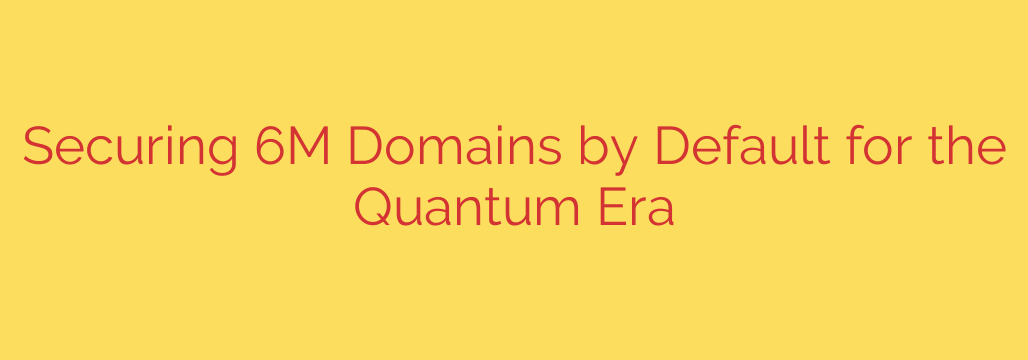
A Quantum Leap in Web Security: Protecting Data from Future Threats
The digital world is on the brink of a monumental shift. For decades, our online security has relied on encryption methods that are incredibly difficult for today’s computers to break. But a new era of computing—quantum computing—threatens to shatter that foundation, rendering much of our current data protection obsolete.
In a massive and forward-thinking move, a significant portion of the web is now being future-proofed against this threat. Millions of domains are being automatically upgraded to use post-quantum cryptography (PQC), a next-generation security standard designed to withstand attacks from both classical and quantum computers. This isn’t a theoretical exercise; it’s a real-world deployment happening right now, securing a vast slice of the internet by default.
Understanding the Quantum Threat to Encryption
To appreciate the scale of this upgrade, it’s essential to understand the danger. Modern encryption, used in everything from banking to secure messaging, is built on mathematical problems that are practically impossible for even the most powerful supercomputers to solve.
However, quantum computers operate on entirely different principles. Once they reach sufficient scale and stability, they will be able to solve these complex problems with alarming speed using algorithms like Shor’s algorithm. This means that data we consider secure today could be easily decrypted in the future.
This leads to a critical and immediate security risk known as “harvest now, decrypt later.” Malicious actors are already capturing and storing vast amounts of encrypted data today, betting that they will be able to break the encryption once a powerful quantum computer is available. This makes sensitive information with a long shelf-life—such as financial records, government secrets, and personal health data—extremely vulnerable.
The Proactive Solution: Deploying Post-Quantum Cryptography
The transition to Post-Quantum Cryptography (PQC) is the definitive answer to this looming threat. PQC involves developing new cryptographic algorithms based on mathematical problems that are believed to be difficult for both classical and quantum computers to solve.
Instead of waiting for the threat to become a reality, web infrastructure leaders are taking a proactive stance. The automatic rollout of PQC for millions of websites is a landmark event in cybersecurity history. It marks a shift from optional, advanced security to a new baseline where next-generation protection is the default standard.
This rollout utilizes a hybrid implementation for maximum security and reliability. Here’s how it works:
- Classical Encryption: Each connection is still secured with a traditional, battle-tested algorithm (like Elliptic Curve Cryptography). This ensures protection against all of today’s threats.
- Post-Quantum Encryption: In parallel, the connection is also secured with a new, quantum-resistant algorithm (such as CRYSTALS-Kyber, a standard selected by NIST).
This dual-layer approach offers the best of both worlds. It provides a safety net, ensuring that even if an unforeseen weakness is discovered in the new PQC algorithms, the connection remains protected by proven classical methods.
What This Means for Website Owners and Users
One of the most impressive aspects of this large-scale deployment is its seamless nature.
- For website owners and administrators, this upgrade requires no action. The security enhancements are being applied at the network level, providing quantum resistance without any need for configuration changes or software updates. Your site becomes more secure automatically.
- For internet users, the transition is completely invisible. There is no noticeable impact on website performance or the user experience. You can continue to browse, shop, and communicate with the assurance that your data is being protected against the threats of both today and tomorrow.
This “secure by default” philosophy is a powerful step toward building a more resilient and trustworthy internet for everyone.
Actionable Steps for a Quantum-Ready Future
While this automatic upgrade is a monumental step, organizations should still be proactive about their quantum readiness. Here are a few security tips to consider:
- Audit Your Data: Identify which of your stored data has a long-term sensitivity. This is the information most at risk from “harvest now, decrypt later” attacks.
- Consult Your Vendors: Ask your key technology and security partners about their PQC roadmap. Ensure the tools and services you rely on are preparing for the quantum era.
- Educate Your Team: Raise awareness within your IT and security teams about the implications of quantum computing. Understanding the threat is the first step toward building a comprehensive defense strategy.
The move to post-quantum cryptography is no longer a distant concept. It is happening now, fundamentally strengthening the security and privacy of the internet for years to come.
Source: https://blog.cloudflare.com/automatically-secure/








